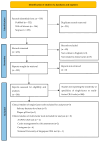Updates on Caries Risk Assessment-A Literature Review
- PMID: 39452440
- PMCID: PMC11506515
- DOI: 10.3390/dj12100312
Updates on Caries Risk Assessment-A Literature Review
Abstract
This narrative review aims to provide an update on caries risk assessment (CRA) and the available CRA tools. CRA can be used to monitor the status of oral care, as well as for documentation and research purposes. Caries risk is determined by the interplay of risk and protective factors. Common risk factors include suboptimal oral hygiene practices, previous caries experience, low plaque acidity, frequent snacking, cariogenic diet, enamel defects, reduced salivary flow, polypharmacy, and radiotherapy experience. Caries risk can be reduced through some preventive measures, such as the use of fluoride, gum chewing, dental sealants. The CRA process can be categorized as single or multifactor tools. Single-factor CRA tools include diet analysis questionnaires, cariogenic bacteria testing and saliva testing kits, whereas multifactor CRA tools encompass Caries Management by Risk Assessment (CAMBRA), Cariogram, and PreViser. Some CRA tools may quantify risk and protective factors to compute caries risk. Additionally, they can generate visual and educational presentations that foster success in oral care. Clinicians consider CRA beneficial for developing personalized care plans. However, the literature fails to reflect this and reveals limited studies supporting its use as evidence-based practice for caries management.
Keywords: caries risk assessment; cariology; dental caries; oral health; preventive dentistry.
Conflict of interest statement
The authors declare no conflicts of interest.
Figures
References
-
- Almerich-Torres T., Montiel-Company J.M., Bellot-Arcís C., Iranzo-Cortés J.E., Ortolá-Siscar J.C., Almerich-Silla J.M. Caries Prevalence Evolution and Risk Factors among Schoolchildren and Adolescents from Valencia (Spain): Trends 1998–2018. Int. J. Environ. Res Public Health. 2020;17:6561. doi: 10.3390/ijerph17186561. - DOI - PMC - PubMed
Publication types
LinkOut - more resources
Full Text Sources


